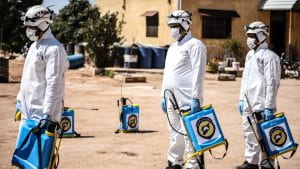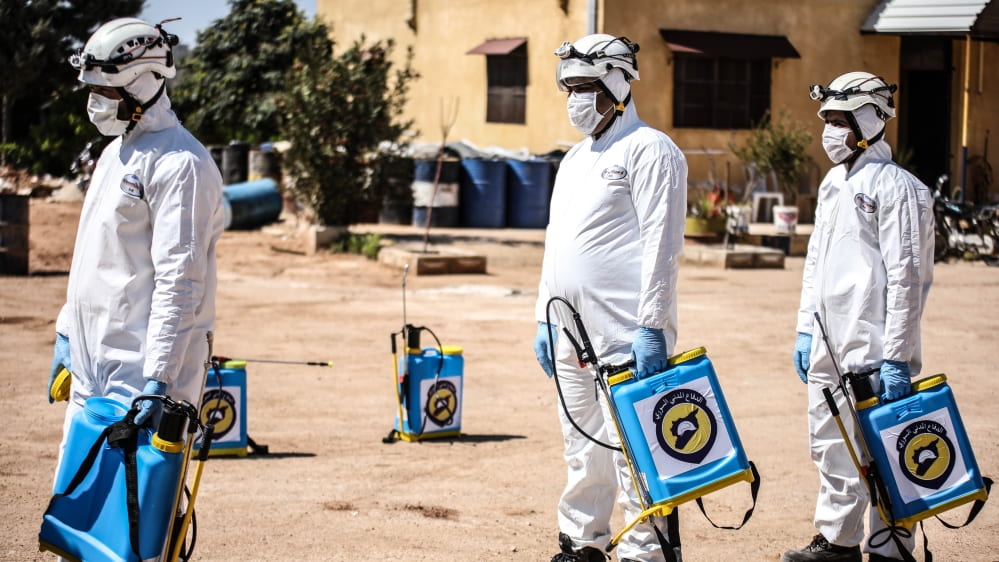
“Wash your hands.” “Avoid close contact with others.” “Stay home.” These are the CDC’s recommendations for protecting yourself against the coronavirus and the disease that it causes, COVID-19. For those of us fortunate enough to have clean water and soap and space and a home, that is helpful advice and easy enough to follow, even if it is somewhat of a disruption to our normal lives. Unfortunately, these recommendations are completely irrelevant to the millions of people across the globe who live in conflict zones and refugee camps where fresh water is scarce, sanitary facilities are lacking, and the healthcare infrastructure has been decimated by war and continuous violence. In places where day to day survival is already a key concern, the novel coronavirus poses a new kind of threat, one that the struggling healthcare systems in these countries is not prepared to take on.
While the U.S. government and media have focused on individual vulnerabilities, such as age and underlying respiratory conditions, very little has been done to address social and structural vulnerabilities, including limited access to basic services, health care, safe water, sanitation, and hygiene, in some of the most dangerous places in the world. Overcrowded refugee camps are a virus’ dream – they provide conditions in which the virus can spread rapidly and easily. Individuals living in these places are already prone to respiratory problems due to air pollution and living in close quarters. Unsanitary conditions and lack of housing, food, and clean water exacerbate the risk of contracting an infectious disease, and the lack of access to basic health care makes fighting any kind of infection difficult. The coronavirus is highly contagious and has a very high global mortality rate, even in places where social distancing and healthcare are accessible, and this rate will likely be significantly higher in conflict zones where large numbers of displaced people live. Preventing the virus from entering these spaces is the only hope, but as Dr. Esperanza Martinez, head of health for the International Committee of the Red Cross, has said, “this is uncharted territory,” and it is unclear how effective containment strategies will be in reality (or if they are even possible in certain places).
According to the Center for Strategic and International Studies, 126 million people around the world are in need of humanitarian assistance, including 70 million who have been forcibly displaced from their homes, mostly due to violence. COVID-19 is adding a new layer of uncertainty and fear to the already precarious and vulnerable status of these individuals and families. The UN High Commissioner for Refugees (UNHCR) and the International Organization for Migration have suspended refugee resettlement programs, and many governments worldwide have stopped the intake of refugees who are fleeing violence and food insecurity. Cases of COVID-19 have been confirmed in war-torn areas in the Middle East, including Afghanistan, the Gaza Strip, and Ninevah, a displaced persons camp in Iraq, as well as in several African countries, including war-torn Libya, Cameroon, and the Congo. This post considers how this global pandemic will likely impact people living in three particularly dangerous and vulnerable countries in the Middle East and West Africa: Syria, Yemen, and Burkina Faso.
Syria
Nine years into the seemingly endless civil war in Syria, more than 380,000 people have died, dozens of towns and cities razed to the ground and half of the country’s entire population displaced. Targeted attacks have left Syria’s once thriving public health care system in shambles. Hospitals and clinics have been destroyed or damaged to the point of not functioning. Medicine and medical supplies are limited, healthcare workers are few, and travel to the still-operational clinics and hospitals is out of the question for many of the sick and suffering. Of particular concern is the refugee camp in Idlib, a town in the northwestern province near Turkey, where many displaced individuals now live. The conditions of the camp are dire – there is limited access to soap and water and overcrowding makes social distancing impossible – so self-protecting is a major challenge.
Syria reported its first case of coronavirus a few days ago, from a woman who had recently traveled to Iran, a country that is backing the Syrian government in the civil war and where Shia pilgrims frequently travel. There are now five confirmed cases (the actual number is suspected to be much higher), and there is growing fear that the virus is spreading unimpeded throughout the northwest, where there is limited capacity to test and monitor the situation, but experts have warned that “if the disease starts, it will spread massively.” Jan Egeland, director general of the Norwegian Refugee Council, has warned that COVID-19 could “decimate refugee communities.” Containment is the only hope, but the shortage of supplies, including test kits, makes this unlikely.

Yemen
The United Nations has labeled the situation in Yemen the world’s worst humanitarian crisis. No cases of COVID-19 have been confirmed yet in Yemen, but the country is bracing for a devastating catastrophe if and when the virus arrives. Since the U.S.-backed war in Yemen began five years ago, Saudi and Emirati coalitions have leveled 120 attacks on medical facilities throughout the country. These attacks, including airstrikes, ground-launched mortar and rockets, and attempts to occupy hospitals and clinics, have led to widespread disruptions in access and service to some of the world’s most vulnerable people, including displaced women, children, and persons with disability. With a mere 51% of the country’s health centers operational, there is a severe shortage of medicine and medical equipment. Even if people in this area can get to a hospital, many hospitals don’t have electricity, rendering a ventilator — a potentially life-saving device for people suffering the most severe symptoms of COVID-19 — out of the question. The decimated healthcare infrastructure is unable to control preventable disease (there was a cholera outbreak a few years ago) and is completely ill-equipped to handle a pandemic. Both the Houthi rebel group (aligned with Iran) and the government recognize the threat the virus poses and are implementing precautionary measures, such as closing schools and halting flights into the area. However, both sides are amping up their rhetoric and are posed to blame the other if and when cases of COVID-19 are confirmed. The United States, for its part, has cut off emergency aid to Yemen, citing the Houthi’s interference in the distribution of supplies and services to starving Yemenis (likely a Saudi-directed approach), but humanitarian officials have warned that this decision will create major funding gaps in efforts to provide hand soap and medicine to clinics and to staff health centers with trained healthcare workers. Yemen’s basic healthcare programs are heavily reliant on foreign aid – about 8 out of 10 Yeminis rely on some form of aid. Eliminating this source of funding could mean suffering and death for millions of displaced persons in Yemen.
Burkina Faso
On March 18, Burkina Faso, the impoverished West African country of 20 million people, registered its first confirmed case of COVID-19. A week and a half later, that number leapt to146 cases, with hundreds more suspected, making it the hardest hit West African country so far. This tiny, conflict-scarred country is no stranger to hardships, including poverty, drought, rampant hunger, and militia-led coups. In 2019, clashes between government forces and militia groups linked to ISIL and al-Qaeda led to more than 2,000 deaths in Burkina Faso and forced more than 700,000 people to flee their homes. This escalation of violence has led to the closure of 135 health centers in the country, and an additional 140 have reduced their services, leaving 1.5 million Burkinabe in dire need of humanitarian health assistance. With a healthcare system that has been ravaged by war, a mere three facilities in the country are able to carry out the tests, and only a few hundred test kits have been provided. As part of the government’s response, Malian refugees once displaced into Burkina Faso are being forced back into Mali, where ongoing violence inhibits humanitarian and medical access to affected populations. COVID-19 will exacerbate an already dire situation — it is feared that an outbreak would see fatality rates of ten times higher than the global average. “These populations are already very vulnerable to diseases that are otherwise easy to treat,” says Alexandra Lamarche, senior advocate for West and Central Africa at Refugees International, “but that’s not the case when they have no access to water or proper sanitation or health care.” She adds, “We could watch entire populations vanish.”

Against a common enemy?
Rarely does a disaster – natural or otherwise – affect the entire world. The coronavirus is a different story, unlike anything we have witnessed in the modern age. It is exposing the fragility of even the most advanced economic, technological, social and medical systems, and it poses a grave threat to humans the world over. The virus doesn’t discriminate on the basis of status or religion or skin color or any of the other things that divide us or give us cause to fight each other. It travels across borders and between enemies, and the more people it infects, the greater the risk for everyone. Just like the virus, the distribution of basic human rights must not be qualified on the basis of anything other than humanity. Turning a blind eye to the suffering and inadequate conditions of the world’s most vulnerable populations only facilitates the spread of the virus. In a practical sense, limiting the spread of the virus in refugee camps and conflict zones in Yemen and Syria and West Africa is just as important as it is in wealthy countries if the goal is to eliminate the virus and end this global pandemic. That requires distributing resources and investing in large-scale infrastructure improvements in places where people are not able to follow the protocols for containment under the current conditions. As we scramble to make enough surgical-grade masks for healthcare workers in the United States to wear, we need to be concerned with sending as many as possible to medical facilities in places around the world that are under-served and over-taxed, including displaced persons camps. We cannot hope to protect ourselves if we refuse to protect our fellow humans, no matter the distance or cultural difference between us. U.N. Secretary-General Antonio Guterres has called this “the true fight of our lives,” insisting that we put aside our differences, which now seem small and inconsequential, and turn our aggression toward a common enemy. “That is what our human family needs, now more than ever.”

